This article was co-authored by Anthony Stark, EMR. Anthony Stark is a certified EMR (Emergency Medical Responder) in British Columbia, Canada. With over 11 years of experience, he has worked as an industrial medic and provided urban and rural paramedic services. He currently works for Mountain View Safety Services and previously worked for the British Columbia Ambulance Service. Anthony has a Bachelor of Engineering in Electrical, Electronics, and Communications Engineering from the Georgia Institute of Technology. He has completed the EMP Canada EMT Course and Swiftwater Awareness Training associated with the British Columbia Ambulance Service.
This article has been viewed 487,622 times.
The most common reason to tape a thumb is due to a sprain-type injury, usually caused by the thumb bending too far backward while skiing or playing sports such as basketball, volleyball or football.[1] When the thumb is moved beyond its normal range of motion, the ligaments get torn to some degree — severe sprains can involve completely severed ligaments, for example. Taping a sprained thumb restrains movement, protects it from further injury and allows it to heal in a timely fashion. Thumb taping can also be used by athletes to help prevent injury.
Steps
Preparing the Thumb for Taping
-
1Assess the seriousness of the injury. Taping an injured thumb is helpful if the injury is a sprain, strain or slight dislocation, but it's not a good idea for fractured or badly cut thumbs. Sprained thumbs cause mild-to-moderate sharp pain and often lead to some inflammation, redness and bruising.[2] In contrast, a broken or severely dislocated thumb is typically very painful, looks crooked, moves unnaturally, and involves considerable inflammation and internal bleeding (bruising). These more serious types of injuries are not candidates for thumb taping and require immediate medical attention instead, which often involves splinting, casting and/or surgery.
- Do not tape a severely cut thumb. Instead, clean the wound, put pressure on it to stop or slow the bleeding and wrap it in a bandage (if possible) before going to the hospital for an assessment.
- "Buddy taping" fingers together for support and protection is common for sprain injuries, but the thumb cannot be taped to the index finger. Doing so would put the thumb in an unnatural position and risk further injury. It would also prevent the index finger from being functional.
-
2Remove any hair from the area. Once you've decided that your thumb injury is appropriate to tape, grab a safety razor and shave the entire area around the thumb and back of your hand (stopping at your wrist). The purpose of shaving the skin is to make the tape adhere better and to prevent irritation and pain when you need to take the tape off. In general, it's recommended that you shave the skin about 12 hours prior to taping, which allows it to heal from any irritation caused by the shaving.[3]
- Make sure to use shaving cream or other lubricants while shaving because it will reduce the risk of any nicks or cuts to your skin.
- After you finish shaving, the skin should be thoroughly cleaned to remove any oils and sweat, then dried with a clean cloth. Don't apply any moisturizers because the tape won't stick as well.
- Alcohol wipes are great for cleaning skin. The isopropyl alcohol is not only a good antiseptic, but it also gets rid of any oily or greasy residues that might prevent the tape from sticking to your skin.
Advertisement -
3Consider spraying an adhesive over the area. Cleaning your skin with soap and water and/or alcohol wipes is usually sufficient for the tape to stick well, but consider using some adhesive spray to get the best contact.[4] Spray the adherent to your wrist, palm, thumb and back of your hand, then allow it to dry and become slightly tacky. Adhesive spray better prepares your skin for the athletic tape and prevents discomfort to sensitive skin while allowing easy removal.
- Adhesive spray can be purchased at most pharmacies and all medical supply stores. Your physiotherapist or athletic therapist is also likely to have some.
- Avoid breathing in as you spray the adherent because it can irritate your lungs and cause coughing spasms or sneezing.
-
4Use an underlying wrap for sensitive skin. Although hypoallergenic (low-irritant) tape is widely available, those with especially sensitive skin should consider pre-wrapping their thumb and hand with a hypoallergenic underlay.[5] Underlying hypoallergenic wraps are thin and soft and meant to go underneath the athletic tape.
- Be careful not to wrap the underlying material too tight, particularly if you have diabetes or a circulatory problem, or if the wounded thumb has been swelling or is discolored, as the bandage and underlay can become too binding. This may lead to tissue damage.
- Hypoallergenic underlying wraps are usually sold at the same places as athletic tape, adhesive spray and other medical and physical therapy supplies.
Taping Your Thumb
-
1Lay down an anchor first. Place a strip of tape in a comfortable (not too tight) ring around the base of your wrist, just below the bony prominences. This strip is considered an anchor, which gives support and provides fixation points for the various taping methods you can use to tape or strap your thumb.[6] Before taping the forearm area, make sure to position your wrist / hand in a neutral position — your wrist should be extended backwards a little.
- Apply anchors gently and with care to prevent circulatory problems. If it's too tight, your hand/fingers will tingle, feel cooler to the touch and start to turn bluish.
- You may also wish to add an anchor near the end of your thumb — near the most distal joint. However, this can sometimes cause the entire scaffolding come loose and get dirty. The single anchor around the wrist often works best with the figure eight loops around the thumb.
- The best tape to use for the thumb is adhesive, water resistant, non-stretch (rigid), and between 25 – 50 mm in width.[7]
-
2Make a side loop. With your tape anchors laid down, make a side loop of smaller tape, (usually 10 or 20 mm maximum) at the hollow where you would take your pulse, just beneath the mound of your thumb. Wrap up your thumb, looping the tape around your thumb comfortably along the line of the webbing of your finger. Carry the tape back down, crossing it over the first strip and attaching it to the anchor tape directly beneath the index finger. The loop of tape should look like an 'awareness ribbon' wrapped around your thumb. Make at least two side loops. Your thumb should also be in a neutral position — look at the healthy hand in resting position for a guide.
- For more support and rigidity, make three or four loops around the base of your thumb with the athletic tape.
- The loops should not pull your thumb back so far that it looks like you're hitchhiking. Remember that your thumb may be hypermobile due to stretched ligaments, so try to tape it in a neutral position.
-
3Make a front loop. After securing the side loop, make a few more in the opposite direction, which are called front loops.[8] As the name implies, front loops start at the front of your wrist / forearm, then loop around the back of your thumb and return to the frontal (anterior) wrist area. Make at least two loops for good support or a few more if greater rigidity is required or wanted.
- An alternative method for providing more stability is to take lengths of two inch (50mm) tape and wrap these over the loops, in the same direction as the anchor tape. Cover from where the loop tape starts at the back of the hand to the fleshy part of the palm under the thumb. Take these strips from anchor tape to the first joint of the thumb to support the muscles that attach the thumb to the hand.
- Thumb taping should only be used if it is comfortable and does not cause more damage to the injury.
- The tape should not be too tight because this will prevent blood flow to the thumb and this will cause more damage.
-
4Tape over the distal joint if it's sprained. There are two joints in the thumb: the proximal one closer to the palm, and the distal one closer to the thumbnail. The side and front loops are more for securing and supporting the proximal joint, which is sprained / injured more often. However, if the distal thumb joint is sprained or slightly dislocated, then wrap a few strips of tape directly over it and connect to the thumb anchor.[9]
- When this joint is involved, make sure the taping holds the thumb closer to the rest of the hand, to avoid catching the rigid, taped distal joint and re-injuring it.
- There's no need to tape the distal joint if the proximal thumb joint is sprained because you'll have almost no mobility in your thumb.
- Tapping directly over the distal thumb joint is a common preventative strategy in sports such as football, rugby and basketball.
Warning
- Be careful taping your thumb if you have diabetes, circulatory problems or peripheral artery disease as any significant reduction in blood circulation, such as from taping too tight, increases the risk of tissue injury or death (necrosis).
References
- ↑ http://www.sportsinjuryclinic.net/sport-injuries/wrist-pain/sprained-thumb
- ↑ https://my.clevelandclinic.org/health/diseases_conditions/hic_musculoskeletal_pain
- ↑ http://www.physioadvisor.com.au/12460050/thumb-taping-thumb-strapping-strap-thumb-phy.htm
- ↑ http://www.ncbi.nlm.nih.gov/pmc/articles/PMC1317813/?page=1
- ↑ http://www.physioadvisor.com.au/12460050/thumb-taping-thumb-strapping-strap-thumb-phy.htm
- ↑ http://www.physioadvisor.com.au/12460050/thumb-taping-thumb-strapping-strap-thumb-phy.htm
- ↑ http://www.physioadvisor.com.au/12460050/thumb-taping-thumb-strapping-strap-thumb-phy.htm
- ↑ http://www.physioadvisor.com.au/12460050/thumb-taping-thumb-strapping-strap-thumb-phy.htm
- ↑ http://www.ncbi.nlm.nih.gov/pmc/articles/PMC1317813/
About This Article
To tape a thumb, keep in mind that taping is best for a sprain, strain, or slight dislocation, but it's not a good idea if your thumb is fractured or badly cut. To get started, place a strip of tape in a comfortable ring around the base of your wrist as an anchor. Once you've done that, make a side loop of smaller tape at the hollow where you would take your pulse, winding the tape around your thumb and attaching it to the anchor. Then, for good support, make a front loop by starting at the front of the wrist and looping around the back of the thumb. To learn how to tape over the distal joint if the thumb is sprained, keep reading!




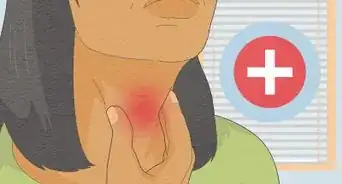



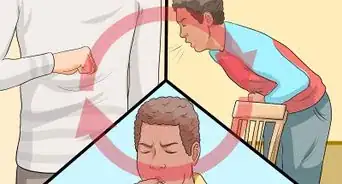


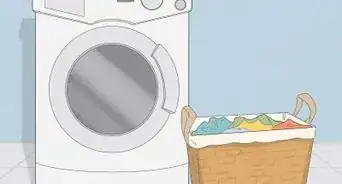

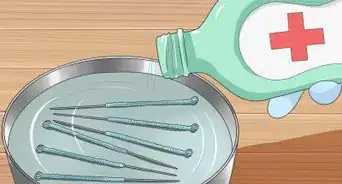











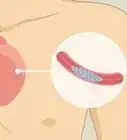

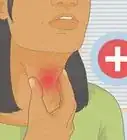



































Medical Disclaimer
The content of this article is not intended to be a substitute for professional medical advice, examination, diagnosis, or treatment. You should always contact your doctor or other qualified healthcare professional before starting, changing, or stopping any kind of health treatment.
Read More...